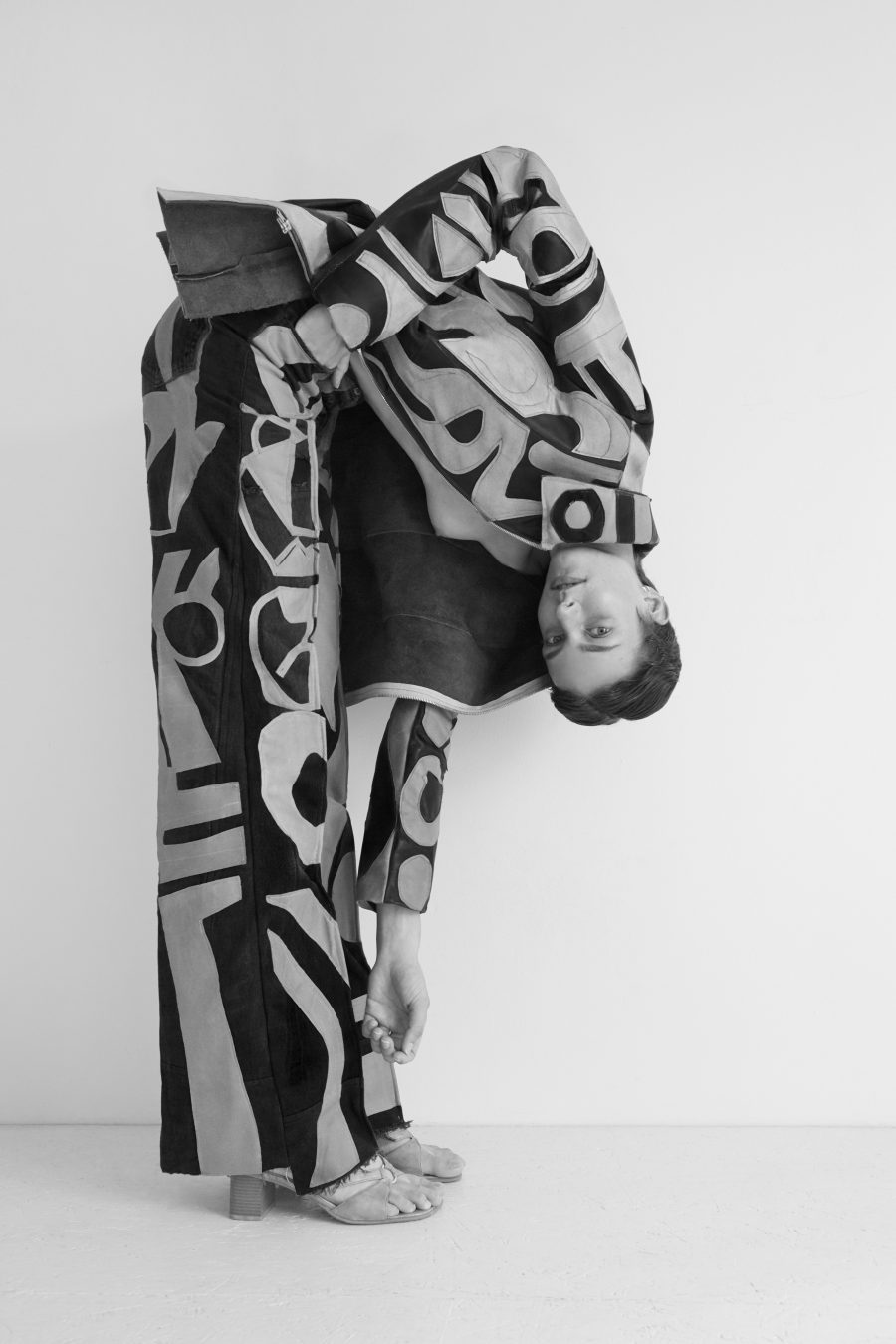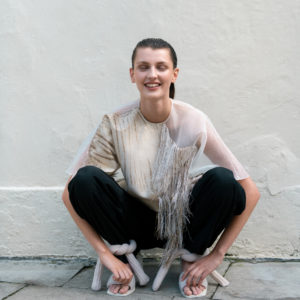Amsterdam based Marije Stein is somewhat of an accidental fashion designer. Her artistic and craft based approach means that she has not always fit into the traditional fashion system. Carving out her own niche has led Marije to create garments that are not only unique, but offer the wearer a sensory experience. Also catches up with Marije about her latest collection that is hand crafted from discarded leather furniture. Pull up a chair!

Tell us how you started making clothes?
It wasn’t a childhood dream of mine to make clothes, but I was always crafting things, painting and drawing etc. In high school I completely ditched all that, being way too busy with boys and Bacardi Breezers. After high school I studied psychology for a bit and then travelled for a while where I met some people who were studying fashion. That was the first time I thought of the possibility of studying or doing something creative professionally, before that it never even crossed my mind. Initially it was the craftsmanship in the making that particularly intrigued me. I thought to be able to construct garments would be such a great skill to have.

So how did you get into fashion design?
I did one year of fashion school, but that didn’t work for me. The ‘fashion world’ wasn’t what I had expected it to be, I was so bummed. There were so many things I wanted to do and try out but there were so many rules that discouraged me. After that I went to art school (Gerrit Rietveld Academy) knowing absolutely sure I never wanted to do anything with fashion ever again. After a year of making paintings and sculptures I figured that in this environment I could make clothes in a different way, I could actually paint and sculpt on a body with whatever material I could get my hands on. Whilst still being rather suspicious, this realisation made me decide to give it another shot. There was so much space for experimenting, making mistakes, starting over again. Here the only rule was the relation of the work to the body. To have the freedom to translate every idea into the frame of fashion felt so liberating. Studying there was so much fun!

Do you have a muse in mind when you’re designing?
I do see the clothes on an imaginary person when I’m picturing it in my mind and this person always varies. Sometimes it’s one of my friends, sometimes an old eccentric lady. There is a Moroccan man living in my neighbourhood who dresses insanely well, I would love to put one of my long leather coats on him sometime.
My graduation collection was based on the story of Edith Bouvier Beale, aka Little Edie. In 1975 the Maysles brothers made the documentary ‘Grey Gardens’ about her and her mother. Two reclusive, formerly upper class women, who lived in extreme poverty in their East Hampton mansion, with piles of cat food cans and treasures from the past. They sing, dance and fight with each other all day. Little Edie was once an aspiring dancer and actress and she uses the opportunity of a film crew being present in her house very well. She is a hilarious and very authentic person.

Do you have a philosophy to your design approach?
My process is always quite chaotic and very intuitive, I’m not a good planner and I’m messy but I am learning to embrace this side of me. Because the process is so spontaneous the result is a one-time thing, I cannot reproduce the garments. First I struggled with that; I had to keep track of every step because I need to be able to produce right? But that thought pulled me out of my flow every time so I decided to completely ignore it. All the pieces are unique and this approach really works for me; its simple, clear and direct. I put so much love (and blood, sweat and tears) in every single garment, I hope people can sense that when they see or wear it.
I admire Koos van den Akker’s way of working; as a young guy he moved from Holland to New York in the late 60’s and started to make hysterically collaged, colourful sweaters. These got picked up by Bill Cosby, who started wearing them in the TV show. For the rest of his life Koos went to his studio every morning, sat behind the sewing machine and made clothes all day, which he sold in a small shop close by.
I love the sensory part of wearing a garment, the sound it makes when you move, how it smells, the weight of it on your body. I once made a coat containing 3 heavy-duty woollen duvets, I had to change models last moment because the girl had a shoulder injury and couldn’t wear it. A lot of clothes nowadays are so lightweight and stretchy you hardly feel you have anything on you. And I get that when you want to run or do yoga or whatever, but if you want really tight jeans you first need to go through a little bit of pain in my opinion. I’m not proposing painful clothing though! Quite the opposite; I like big shapes that feel very comfy to wear.

What inspired your current collection?
Part of the collection was a commissioned project initiated by the City of Amsterdam, a group show showcasing garments all made from waste, aiming to create more environmental awareness. At that time the apartment block in front of my house got pulled down and lots of neighbours put their old furniture in the street. I cut away the leather from all the couches, cleaned it, and re-painted it. The leather used for furniture has an amazing quality, its very thick and sturdy. Some of it was so old; you could see the creases of someone’s butt that had sat on it for years. I randomly cut big figurative shapes and stripes from the leather, arranging and re-arranging them to finally compress them into clear, archetypal clothing pieces.

What advice would you offer to aspiring designers creating their own label?
Don’t think too much. Really try to think only the absolutely necessary and let your hands do the work. When you doubt yourself you tend to overanalyse your work and make decisions based on rationality. I still fall into that trap sometimes. Aim for a state of effortless ease and unselfconsciousness. In old Chinese thought this is called wu-wei, which means; ‘Trying not to try’ or ‘effortless action’.

What’s next for Marije Seijn?
I will continue roaming the streets looking for old furniture to make more leather pieces from, including bags. I’m also interested in jewellery making. I made huge figurative metal wire earrings for the latest collection and I would love to learn some techniques to make them more sturdy and wearable. As well as clothing making I recently picked up painting and drawing again which I woud like to develop more. To approach the human body in a different way reinforces both disciplines I think.

All clothing and accessories by Marije Seijn


